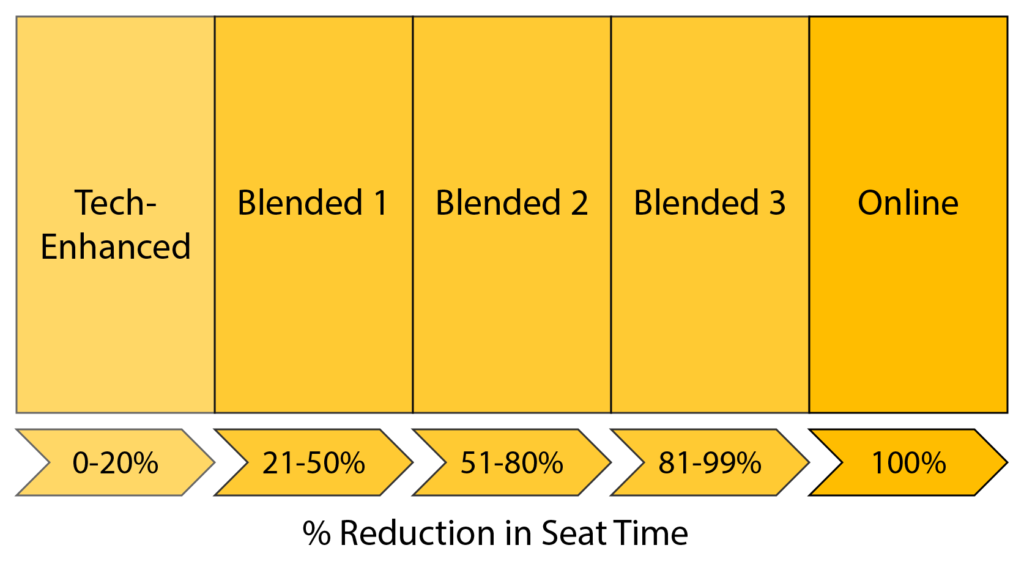Most face-to-face courses can be developed and delivered effectively online with modifications that take advantage of the online modality. However, some course types may require special consideration for moving discipline-specific assessments and activities from face-to-face to online. This resource page provides suggestions for how to facilitate such assessments and activities online.
For more resources related to online instruction, visit the Online and Blended Teaching Program website.
Asynchronous Online
Asynchronous delivery of online courses means that students do the work of the course—such as accessing lecture content, submitting assignments, participating in discussions, and taking online quizzes—at different times. Asynchronous courses usually have due dates that provide students with a window of time to complete the assigned work. Asynchronous delivery is the most common way to offer online courses and addresses issues related to access, equity, and student preference.
Synchronous Online
By contrast, synchronous delivery of online courses means that students must meet in a virtual space, such as Zoom, on specific days and times. In a real-time, synchronous virtual environment, students can run into all sorts of issues, such as trouble logging into the session or audio problems, which can be frustrating for students and difficult for instructors to troubleshoot. However, some activities, such as group project work and virtual office hours, can be done very effectively in a synchronous format.
Blended/Hybrid
 Blended or hybrid courses are courses in which seat time has been reduced by 21–99%. “Blended” and “hybrid” are terms that are often used interchangeably, but in the professional field, “blended” is the preferred term. UWM provides three different “levels” of blended courses to indicate how much of the course is offered online. When blended courses are posted in the official schedule of classes, students have a sense of how much of the course will be face-to-face (F2F) and how much will be online. Blended courses are often considered to be “the best of both worlds” because instructors can incorporate the most effective practices of the face-to-face and online modalities.
Blended or hybrid courses are courses in which seat time has been reduced by 21–99%. “Blended” and “hybrid” are terms that are often used interchangeably, but in the professional field, “blended” is the preferred term. UWM provides three different “levels” of blended courses to indicate how much of the course is offered online. When blended courses are posted in the official schedule of classes, students have a sense of how much of the course will be face-to-face (F2F) and how much will be online. Blended courses are often considered to be “the best of both worlds” because instructors can incorporate the most effective practices of the face-to-face and online modalities.
Content Delivery and Lectures
Most courses have disciplinary content that students need to understand to meet the course learning objectives. Traditionally, content delivery has been provided by instructors via face-to-face lectures. With easy-to-use digital tools now available to instructors, content can be delivered effectively online instead of face-to-face. In fact, online content delivery has distinct advantages—students can review content at their own pace, can easily return to concepts that challenge them, and can use online content to study for assessments; plus, instructors can reuse content from semester to semester.
Content delivery in all courses should be provided online asynchronously. This includes:
- Lectures (using text or PowerPoint with audio)
- Demonstrations (using screen capturing software)
- Videos
- Course Materials
- Readings
- Websites
Assessments
Most assessment types can be completed fully online in Canvas, including assessments that can be digitally uploaded into Canvas or can be administered with existing Canvas tools, such as Quizzes. Assessments facilitated through Canvas have important advantages: students have an ongoing record of their coursework and a sense of where they stand in terms of their course grade; plus, instructors need not worry about losing physical papers, exams, or grade books.
Most assessments should be administered and graded online asynchronously in Canvas. These include:
- Quizzes and Exams in Canvas
- Writing Assignments and Essays
- Handwritten Quizzes and Exams (photographed and uploaded)
- Recorded Student Presentations (using PowerPoint with audio)
Course Types
The following course types may require special consideration for moving discipline-specific assessments and activities online:
- Lecture Courses with Lab Sections
- Lecture Courses with Discussion Sections
- Studio and Performance-Based Courses
- Seminars and Other Courses
Below each course type is a common assessment or activity that is traditionally completed face-to-face, and each bullet point provides suggestions for how to facilitate that assessment or activity online without compromising student learning.
Keep in mind that for all course types, content delivery should be provided online asynchronously, and most assessments should be administered and graded online asynchronously in Canvas.
Lecture Courses with Lab Sections
In-Class Lab Experiments
- Instructors can assign online simulations or virtual labs and require students to submit lab reports or other evidence of learning
- Instructors can record video demonstrations and assign students to watch them and to submit evidence of their learning
In-Class Demonstrations of Statistical and Other Software Applications
- Instructors can record video demonstrations using screen capturing software and require students to submit evidence of their learning
Case Studies and Clinical Applications
- Instructors can use online asynchronous discussion forums to facilitate discussion of text-based case studies and clinical applications
- Instructors can record video simulations for case studies or clinical applications and assign students to watch them and to submit evidence of their learning
Lecture Courses with Discussion Sections
Q&A (Muddiest Points)
- Discussion sections of up to 25 students can be offered online asynchronously or synchronously or both
- Students can post questions about content material to an asynchronous discussion forum or ask questions in real time in an online synchronous session
- It is recommended that discussion sections of more than 25 students be offered online asynchronously
Solving Equations and Problems
- Discussion sections in which instructors help students solve equations or problems can be offered online synchronously, but it is recommended that all sessions be recorded, and an online asynchronous discussion forum also be provided
- Small group problem-solving can be completed asynchronously or synchronously at the groups’ discretion
Studio and Performance-Based Courses
Solo Performances or Skill Demonstration
- Students can submit digital recordings to Canvas of solo dance and musical performances
- Students can deliver speeches and presentations online synchronously if the primary goal of the activity is for students to perform in real time
Collaborative Performances
- Students in groups of 2-4 can enact spoken and visual performances in real time in an online synchronous session; musical performances of any size as well as collaborative performances with more than 5 students cannot be facilitated in an online synchronous session
Student-Created Work in Art and Design
- Students can capture images (for 2D objects) or record videos (for 3D objects) of student-created work
- Students who lack access to required materials, equipment, and studio space will be limited in their ability to participate in the course
Critiques in Art and Design
- Student-created work can be captured or recorded and distributed online for other students to critique asynchronously
- Instructors can facilitate discussions in art and design online synchronously, but it is recommended that all sessions be recorded and an online asynchronous discussion forum also be provided
Seminars and Other Courses
Seminars with up to 25 Students
- Discussions and small group activities can be offered online asynchronously or synchronously or both
- It is recommended that instructors use social annotation tools to prepare students for online synchronous sessions
Discussion-Based Courses with More than 25 Students
- It is recommended that discussions and small group activities be offered online asynchronously
Support Resources
- CETL’s Online and Blended Teaching Program (OBTP) provides practical pedagogical strategies for teaching an online or blended course.
- CETL also provides technology training and support specific to campus-supported instructional tools, including Canvas, Zoom, and My Media.
